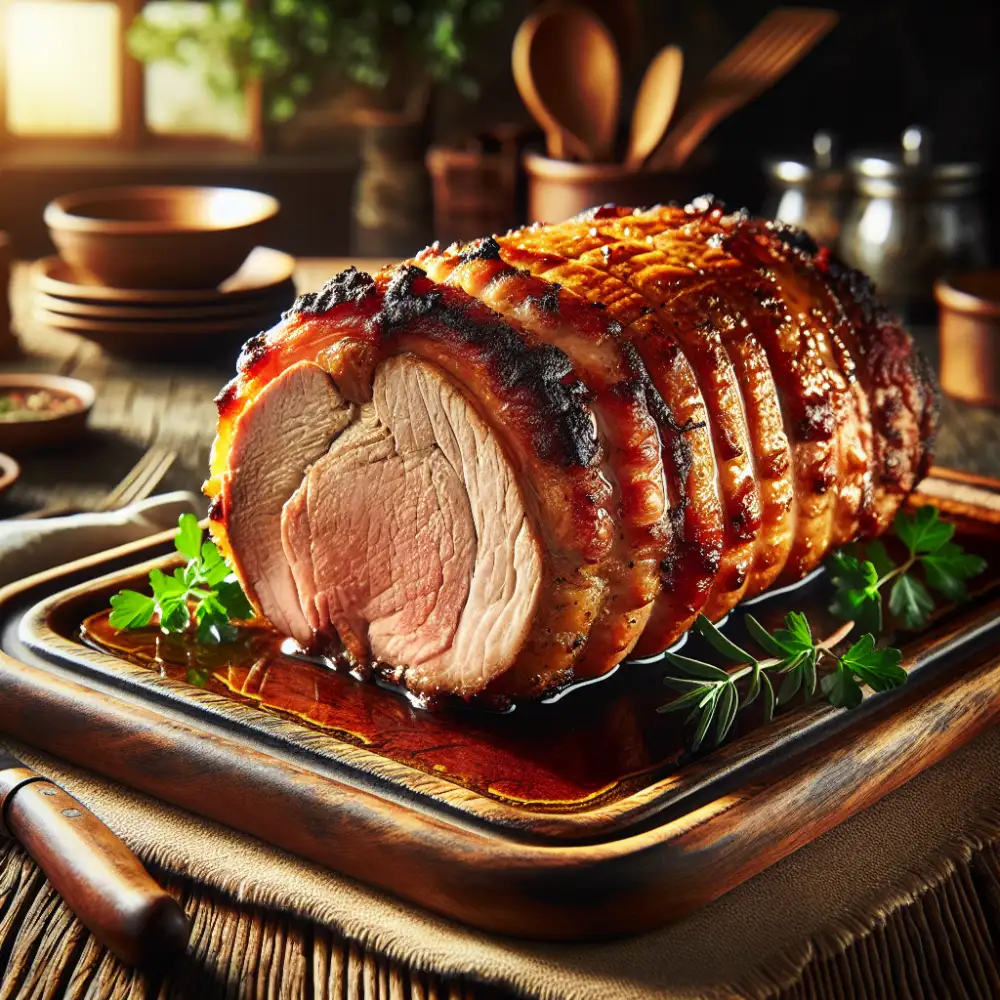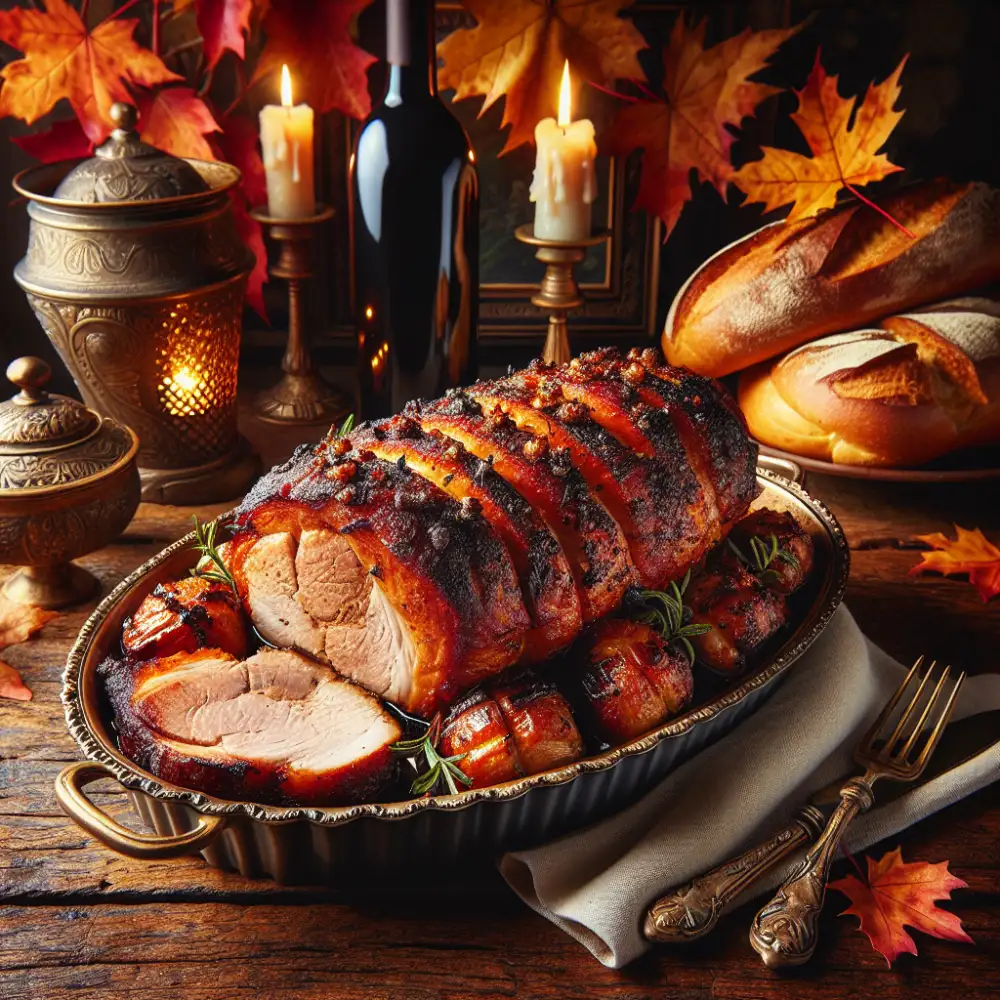Pork Loin Roast: Your New Favorite Sunday Dinner

A pork loin roast is a lean and flavorful cut of meat that can be roasted to perfection in the oven. However, not all pork loin roasts are created equal. The best cut of pork loin for roasting is the center-cut loin roast. This cut is boneless and has a consistent thickness, which ensures even cooking. It is also relatively lean, making it a healthy choice.
When choosing a pork loin roast, look for one that is pale pink in color and has a good amount of marbling. Marbling is the intramuscular fat that helps to keep the meat moist and flavorful during cooking. Avoid roasts that are excessively fatty or have a lot of surface moisture.
The size of the pork loin roast you choose will depend on the number of people you are serving. A 1-pound roast will typically feed 2-3 people, while a 2-pound roast will feed 4-6 people. If you are cooking for a larger crowd, you can purchase a larger roast, but keep in mind that it will take longer to cook.
Once you have chosen your pork loin roast, it is important to season it properly. A simple rub of salt, pepper, and garlic powder is all you need to enhance the natural flavor of the pork. You can also add other herbs and spices to your liking, such as rosemary, thyme, or sage.
When roasting a pork loin, it is important to use a meat thermometer to ensure that it is cooked to the proper internal temperature. The USDA recommends cooking pork to an internal temperature of 145 degrees Fahrenheit. This will ensure that the pork is cooked through and safe to eat, while still remaining juicy and flavorful.
Seasoning and flavor pairings
Pork loin is a blank canvas for flavor, readily absorbing whatever seasonings you choose. For a simple yet delicious approach, a dry rub is your best friend. Classics like garlic powder, onion powder, paprika, dried thyme, and oregano always deliver. Want to turn up the heat? Add a pinch of cayenne pepper or smoked paprika. For a more adventurous palate, explore herbs like rosemary, sage, or tarragon, especially when paired with citrus zest.
When it comes to flavor pairings, pork loin loves the company of both sweet and savory companions. Apples are a classic pairing, their sweetness playing beautifully against the savory pork. Consider adding sliced apples to the roasting pan to caramelize alongside the meat. Other fruits like pears, figs, or even grapes offer a sophisticated twist. On the savory side, mustard is a must-try. A simple glaze of Dijon mustard adds a tangy kick, while whole grain mustard brings texture and a more robust flavor. Don't forget about vegetables! Root vegetables like carrots, potatoes, and parsnips roast beautifully alongside pork loin, soaking up all those delicious juices. For a pop of color and freshness, serve your roast with a side of garlicky green beans or a bright salad.

Roasting techniques for success
Pork loin is a lean cut of meat that benefits from gentle cooking methods to retain moisture and flavor. Roasting is an excellent way to achieve tender and juicy results. Here are some techniques for roasting pork loin to perfection:
Start with a good quality pork loin roast. Look for a roast that is about 2-3 pounds and has a good amount of marbling. Pat the roast dry with paper towels and season generously with salt, pepper, and your favorite herbs and spices.
Preheat your oven to 350 degrees Fahrenheit (175 degrees Celsius). Place the pork loin roast on a rack in a roasting pan. This will allow the heat to circulate evenly around the roast and prevent it from steaming.
For a flavorful crust, sear the pork loin before roasting. Heat a large skillet over medium-high heat and add a tablespoon of oil. Once the oil is hot, sear the pork loin on all sides until browned. This will help to lock in the juices and create a flavorful crust.
Roast the pork loin for 20-25 minutes per pound, or until a meat thermometer inserted into the thickest part of the roast registers 145 degrees Fahrenheit (63 degrees Celsius). The internal temperature of the pork loin should reach 145 degrees Fahrenheit (63 degrees Celsius) to ensure that it is cooked through and safe to eat.
Once the pork loin is cooked to your liking, remove it from the oven and let it rest for 10-15 minutes before slicing and serving. This will allow the juices to redistribute throughout the meat, resulting in a more tender and flavorful roast.
To add extra flavor and moisture to your pork loin roast, consider stuffing it with herbs, fruits, or vegetables. Apples, onions, garlic, and rosemary are all classic pairings that complement the flavor of pork. Simply cut a pocket into the pork loin, stuff it with your desired ingredients, and tie it closed with kitchen twine before roasting.
Another technique for adding flavor is to use a marinade or brine. Marinating the pork loin for at least 4 hours or overnight in a mixture of herbs, spices, and acidic ingredients like citrus juice or vinegar can help to tenderize the meat and infuse it with flavor.
When it comes to serving your roasted pork loin, the possibilities are endless. Slice it thinly and serve it with roasted vegetables, mashed potatoes, or a simple salad. You can also use leftover pork loin in sandwiches, salads, or stir-fries.
Doneness temperatures and resting
Pork loin is the least tender part of the pig, so nailing the right temperature is key to a juicy and flavorful roast. The USDA recommends cooking pork to an internal temperature of 145°F (63°C), followed by a 3-minute rest. This ensures any harmful bacteria are eliminated while still keeping the meat moist and tender.

Don't be scared off by this seemingly low temperature! Gone are the days of dry, overcooked pork. Using a meat thermometer is crucial to accurately gauge the internal temperature. Insert the thermometer into the thickest part of the roast, avoiding any bones.
Once your pork loin reaches 145°F (63°C), remove it from the oven and let it rest for at least 3 minutes. Resting allows the juices to redistribute throughout the meat, resulting in a more flavorful and enjoyable eating experience. Tent the roast loosely with foil during this time to keep it warm.
Remember, the temperature of the pork will continue to rise slightly even after it's removed from the oven, a phenomenon known as "carryover cooking." This is another reason why letting it rest is so important.
By following these simple guidelines, you'll be rewarded with a perfectly cooked pork loin roast that's juicy, flavorful, and safe to eat.
Serving suggestions and sides
Pork loin roast is delicious with a variety of sides. Roasted or mashed potatoes are classic pairings that soak up the flavorful juices from the meat. Add a touch of sweetness with roasted sweet potatoes or butternut squash. For a lighter option, opt for a simple green salad with a tangy vinaigrette. Steamed or roasted vegetables, such as broccoli, asparagus, or green beans, provide a nice contrast in texture and flavor. Consider serving the pork loin roast with applesauce, cranberry sauce, or chutney for a touch of sweetness and acidity. Gravy made from the pan drippings is a must-have for drizzling over the meat and sides.
A pork loin roast is like a blank canvas — simple on its own, but with a little creativity, it transforms into a masterpiece of flavor.
Amelia Davenport
Leftover inspiration and recipes
Pork loin roast is one of those magical meals that keeps on giving. After you've savored the juicy, flavorful slices of the roast itself, you're often left with a good amount of tender pork, just begging to be reinvented into delicious new dishes. Don't let those leftovers go to waste! With a little creativity, you can transform your leftover pork loin roast into a week's worth of exciting meals.
One of the simplest and most satisfying ways to use leftover pork loin is in sandwiches. Slice the pork thinly and pile it high on crusty bread with your favorite toppings. Think tangy mustard, crunchy pickles, and maybe a sprinkle of cheese. For a warm and comforting option, try a classic Cuban sandwich, layering the pork with ham, Swiss cheese, pickles, and mustard, then pressing it until warm and melty.
If you're craving something lighter, leftover pork loin is a perfect addition to salads. Toss bite-sized pieces with mixed greens, roasted vegetables, nuts, and a light vinaigrette for a refreshing and protein-packed lunch or dinner. For a more substantial salad, try a hearty grain bowl with quinoa or rice, black beans, corn, avocado, and of course, your flavorful leftover pork.

Don't forget about soups and stews! Leftover pork loin adds incredible depth and flavor to these comforting dishes. Simply shred or chop the pork and add it to your favorite soup or stew recipe during the last 30 minutes of cooking. It's a fantastic way to use up leftover vegetables too. Imagine a creamy potato soup with chunks of tender pork or a hearty minestrone brimming with vegetables and shredded pork.
For a fun and family-friendly option, try using your leftover pork loin in tacos, quesadillas, or burritos. Simply shred the pork and warm it up with your favorite seasonings. Then, let everyone customize their own creations with tortillas, toppings, and salsas.
No matter how you choose to use it, leftover pork loin roast is a versatile and delicious ingredient that can help you create a variety of satisfying and budget-friendly meals. So, next time you roast a pork loin, be sure to make extra! Your taste buds (and your wallet) will thank you.
Published: 07. 07. 2024
Category: Food



